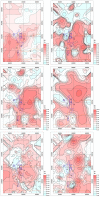Impact of the Coal Mining on the Spatial Distribution of Potentially Toxic Metals in Farmland Tillage Soil
- PMID: 30297728
- PMCID: PMC6175947
- DOI: 10.1038/s41598-018-33132-4
Impact of the Coal Mining on the Spatial Distribution of Potentially Toxic Metals in Farmland Tillage Soil
Abstract
Coal mining areas are prone to hazardous element contamination because of mining activities and the resulting wastes, mainly including Cr, Ni, Cu, Zn, Cd and Pb. This study collected 103 samples of farmland tillage soil surrounding a coal mine in southwestern Shandong province and monitored the heavy metal concentrations of each sample by inductively coupled plasma mass spectrometer (ICP-MS). Statistics, geostatistics, and geographical information systems (GIS) were used to determine the spatial pattern of the potentially toxic metals above in the coal mining area. The results show that the toxic metal concentrations have wide ranges, but the average values for Cr, Ni, Cu, Zn, Cd and Pb are 72.16, 29.53, 23.07, 66.30, 0.14 and 23.71 mg Kg-1, which mostly exceed the natural soil background contents of Shandong Province. The element pairs Ni-Cu, Ni-Zn, and Cu-Zn have relatively high correlation coefficients (0.805, 0.505, 0.613, respectively). The Kriging interpolation results show that the contents of soil toxic metals are influenced by coal mining activities. Moreover, micro-domain variation analysis revealed the toxic metals in the typical area of the coal transportation line. These findings offer systematic insight into the influence of coal mining activities on toxic metals in farmland tillage soil.
Conflict of interest statement
The authors declare no competing interests.
Figures



References
-
- Ivanišević D, Malvić T. Distribution of potentially toxic metals (As, Cu, Hg, Pb and Zn) in the topsoil of the Pannonian Basin System and associated parts of the surrounding orogens. J. Maps. 2016;12:968–974. doi: 10.1080/17445647.2015.1101624. - DOI
-
- Hasani S, Asghari O, Doulati Ardejani F, Yousefi S. Spatial modelling of hazardous elements at waste dumps using geostatistical approach: a case study Sarcheshmeh copper mine, Iran. Environ. Earth Sci. 2017;76:1–13. doi: 10.1007/s12665-017-6852-x. - DOI
-
- Ministry of environmental protection of the People’s Republic of China, Ministry of land and resources of the People’s Republic of China (2014) Investigation communique on soil pollution in China. http://www.zhb.gov.cn/gkml/hbb/qt/201404/t20140417_270670.htm (2014).
Publication types
Grants and funding
LinkOut - more resources
Full Text Sources

